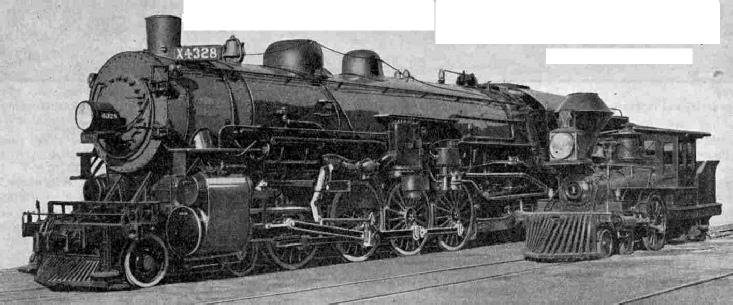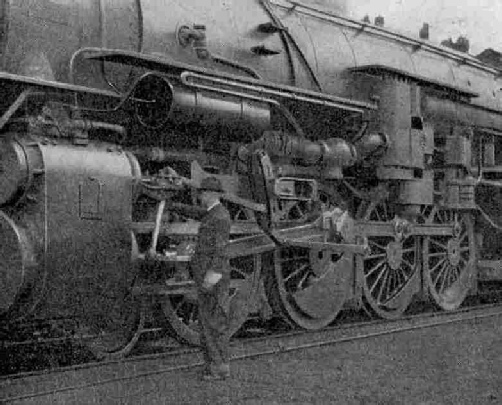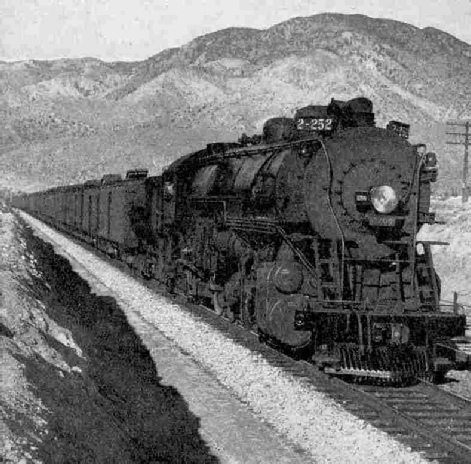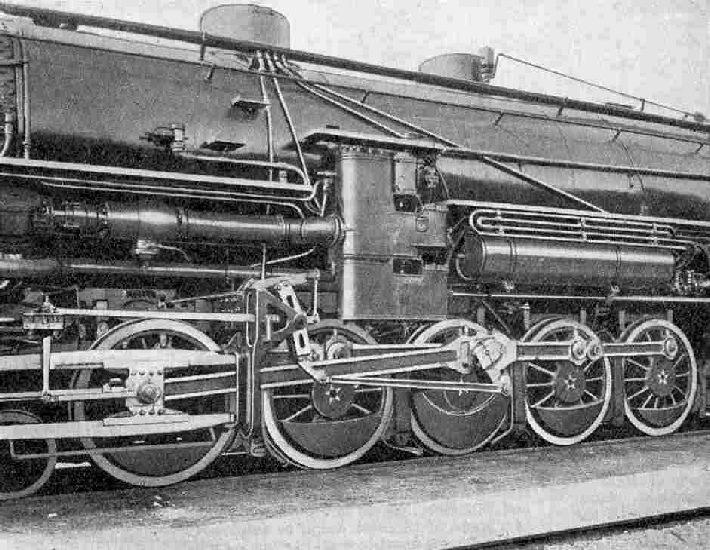Locomotive Development in the United States
LOCOMOTIVES - 62

Sixty-three years of progress. “Southern Pacific No. 1” alongside latest “Mountain” type.
ON 19th August, 1863, the freighter “Herald of the Morning” slowly made its way through the Golden Gate, and docked at San Francisco after the long voyage “round the Horn” from New York.
With difficulty there was unloaded from the hold the first locomotive for the Central Pacific Railroad that ran east from San Francisco. It was christened “Governor Stanford”, in honour of the then Governor of California who, with C. P. Huntington, Charles Crocker and Mark Hopkins, was responsible for the daring project to build a railroad over the Sierra Nevada Mountains to the East. The first rails for the railroad also were unloaded from the ship.
The locomotive and rails were transferred to the schooner “Anna R. Forbes ” for shipment to Sacramento, arriving there on 7th October, 1863. The locomotive was almost lost in the river in unloading, but it was set up finally and its trial trip was held with great ceremony on 11th November. The “Governor Stanford” may be seen to-day in the museum at Stanford University, California.
The locomotive “c. P. Huntingdon”, or Central Pacific No. 3 (renumbered later Southern Pacific No. 1), was placed in service in 1864. It was 29½ ft in length, weighed 39,000 lb and could haul four cars weighing 22 tons each at 35 miles an hour up a grade of 26 ft to the mile. It is still in serviceable condition, but is now only used for exhibiting purposes. The illustration at the head of this page shows this noteworthy little locomotive alongside a modem “Mountain” engine of the type referred to later.
The early locomotives were highly picturesque in appearance. They had large diamond-shaped smoke stacks, and their brass fittings and gay paint made t hem exceedingly ornate. While it was the fireman’s job to keep the brass polished, it is said that some engineers were so proud of their engines that they worked on days off to help to polish them. The drivers and engineers of to-day do not polish, clean, and overhaul the engines on their rest days, but they still take a great pride in their charges, as a visit to any great terminus will demonstrate at any time.

Details of one of the Southern Pacific 4-8 2 freight and passenger locomotives. These are a companion type to the tremendous 2-10-2 freight locomotives that the S.P. has placed on heavy freight service during the last two years.
Instead of merely having serial numbers as at present, the pioneers of the rails had names. Some of them were of historical significance and others indicated the emotions evoked in the minds of those who first beheld them. Thus names such as “Governor Stanford” and “T. D. Judah” were reminders of the men who built the railway; “Red Deer”, “Piute”, and “Grizzly” had Indian or Rocky Mountain associations; while “Jupiter” and “Colossus” were obviously considered enormous engines at the time of their construction.
Wood was the fuel for the first locomotives, familiarly known as “hayburners”. Large quantities of wood were piled along the tracks for use of passing trains and the firemen of those days had a real job. Even after the introduction of coal some of the monsters consumed so much fuel that with hand firing two firemen would find the work almost beyond them. The advent of the mechanical stoker now installed on some of the big locomotives has now made the fireman’s task much easier.
As the communities of the West grew in size and in business importance, better and more powerful locomotives necessary to enable heavier trains to be handled, the same time the size of cars was increased. Heavier rolling stock necessitated heavier rails, and the strength of the supporting roadbed also had to be increased.
One of the most interesting of the early locomotives built by the Central Pacific at the Sacramento shops was the 4-10-0 “El Gubernador” which was in actual service from 1884 to 1893. This iron monster was then said to be the heaviest and most powerful locomotive in the world. When loaded it weighed 234,000 lb.
Tourists were amazed at the size of “El Gubernador”. It was considered too big to be turned on a turntable, for fear it would tip over, and therefore it was kept on the main line, all trains taking sidings when meeting if so there would be no danger of its leaving the rails. Great difficulty was experienced in raising sufficient steam for the large cylinders, but in spite of this defect it did excellent work. A proposal was made to fit a larger boiler, but this did not materialise, and eventually the engine was sent to the scrap heap.
During 1886 and 1888 a number of 4-4-0 type locomotives were built at Sacramento. These engines were very odd in appearance, with only one dome on top. The boiler had a straight top with short front ends and diamond stack. Counter-weights on the “drivers”, instead of being next to the tyre of the wheel, were placed in the wheel centre between axle and tyre.

A powerful and economical 4 -8-2 passenger locomotive of to-day, which regularly maintains the record through run of 815 miles without change, over mountains and desert between El Paso and Los Angeles.
Thirteen locomotives of the 2-8-0 type, familiarly known by engine-men and trainmen as “monkey-hogs”, were built at Sacramento during 1887 and 1888. They were equipped with A. J. Stevens valve gear and originally had steam brakes. They had 19-in by 30-in cylinders set at an angle, 51-in driving wheels, and weighed 202,850 lb loaded. Three or four of them are now being used by outside firms to whom they were sold.
The demand continued for greater and greater service to supply the increasing transportation needs of the growing Western States. Western fruits and products generally were gaining more attention in the East and each year still greater quantities were handled. The West also needed larger supplies each year from eastern manufacturers. By 1894 thirty-ton cars were being used, while the locomotives had more than twice the power of the earlier ones. Two types were then in general use, the 4-6-0 type of passenger locomotive and the 4-8-0 type for freight service, and these were the pride of the rails at the time.
The passenger locomotives of the 4-6-0 type were 57 ft 3-in in length, weighed 239,680 lb and were capable of hauling six coaches weighing 30 tons each at a speed of 50 miles an hour up a grade of 26 ft per mile. These engines handled the “Sunset Limited”, the famous “Millionaire’s Special” that travels over the route between New Orleans, Texas, El Paso and San Francisco , picturesquely described as the “Sunset Route”.
Freight engines of the 4-8-0 type of 1894 were 60 ft 9-in in length, weighed 272,300 lb and could haul 65 cars weighing 30 tons each at a speed of 10 miles an hour up a grade of 26 ft per mile, a remarkable achievement at the time.
The Southern Pacific locomotives built to meet the conditions of to-day are truly giants of the rails.
The most powerful and economical non-articulated (single engine unit) locomotive yet designed was placed in service in 1925 by the Southern Pacific to handle heavy trains over mountain sections of the West. It is known as “Southern Pacific” type, or 4-10-2. This locomotive is of new design, combining all latest developments that have-passed the experimental stage to increase both economy and hauling capacity. It has a third cylinder placed inside the main frames and works with a boiler pressure of 225 lb. The locomotive is 101 ft 1-in in length overall and weighs 682,400 lb. It will further increase efficiency in handling heavy trains, for at a speed of 25 miles an hour, up a grade of 116 ft per mile, it has 25 per cent more hauling capacity than any locomotive previously built fur the Southern Pacific.
The most powerful locomotives in passenger service prior to the advent of the “Southern Pacific” type three-cylinder locomotives were of the 4-8-2, or “Mountain” type. They are 97 ft 6-in in length, weigh 610,300 lb and are 20 times more powerful than Southern Pacific No. 1. Each can pull 14 modern passenger cars, weighing 70 tons each, at 50 miles an hour up a grade of 26 ft per mile. Their great power enables these locomotives to handle heavy trains with ease, while new appliances and refinements in design assure smooth starting and stopping, thus adding to the comfort of passengers. The accompanying illustration conveys an excellent idea of the enormous size of the driving wheels of these remarkable locomotives.
The feats performed by some of the giants of the Southern Pacific Railway are truly remarkable. A new record for a regularly maintained locomotive run was established by the 4-8-2 engines during the latter part of 1923, when the 815 miles between Los Angeles and El Paso was made without change of locomotive. This is now a regular practice, but formerly a relay of four locomotives was considered necessary in speeding transcontinental passenger trains across the mountain and desert territory between the two cities.

Modern Southern Pacific freight locomotive hauling 100 cars without banking engine up a gradient of the Sierra Nevada mountains.
A companion type to the 4-8-2 passenger locomotive is the tremendous 2-10-2 engine that the Southern Pacific has placed in heavy freight service during the past two years. These powerful locomotives are 97 ft 9-in in length and weigh 623,200 lb. They can haul 19 modem freight cars weighing 50 tons each, or a total weight of 4,800 tons, at a speed of 10 miles an hour up a grade of 26 ft a mile.
All the latest type locomotives are equipped with auxiliary booster engines, superheaters, feed-water heaters and other recently approved devices for increasing economy and power. Running gear and frames and other parts have been designed with a view to making, them as light as possible without sacrificing strength. Piston rods, driving axles and main crank pins are of heat-treated steel, hollow bored. Another weight reduction was attained through the use of high tensile strength steel in the connecting rods.
The booster is a separate two-cylinder steam engine geared to the axle of the trailing truck wheels, and its function is to assist the main engine in handling trains at starting and on heavy grades.
The feed-water heater performs the double operation of pumping water from the tender to the boiler and heating it on the way. It utilizes exhaust steam from the main cylinders to heat the water. Part of thus steam is condensed and returned to the boiler for use again, thus reducing sediment and the amount of water required to operate the locomotive.
While constantly striving to develop the finest new locomotives, the Southern Pacific Railroad is not neglecting its old ones. Many passenger and freight locomotives that have been in service for some years are being “rejuvenated” by the addition of superheaters, feed-water heaters, boosters and other modern appliances. In fact 66 per cent, of all Southern Pacific locomotives at the beginning of 1925 were equipped with superheaters, more than 12 per cent, with feed-water heaters, anti many with booster engines. The results are proving most satisfactory, adding greatly to the efficiency and economy of these older locomotives. These as well as other improvements of a highly technical nature are made with the view of giving improved service to shippers and added comfort to passengers.
A few words on the comfort provided for passengers on the transcontinental routes may prove of interest. On all these routes are splendidly equipped trains, which may aptly be described as “travelling hotels”, lighted by electricity, heated throughout or cooled as conditions require, and having spacious smoking and reading rooms. The provision of oil-burning locomotives and rock-ballasted road bed assure a safe and agreeable journey free from soot and cinders.
On account of the great distance from the chief markets of the country, the Pacific coast depends more for its prosperity upon good and adequate transportation than other sections. A vast, well-built transportation machine and a highly efficient organisation are required to take fruit fresh from a Pacific coast orchard, move it over two or three ranges of mountains, and carry it across deserts and plains with such dispatch that it may be placed on someone’s breakfast table in New England as fresh and appetizing as if just gathered from the orchard. The Southern Pacific’s swift, powerful locomotives help to make possible this triumph in transportation.
The progress of any country, it has been well said, is indicated by the progress of its transportation service, and surely this is particularly true of the West and its pioneer railroad, the Southern Pacific.

A close-up view of a Southern Pacific 4-10-2 type showing valve gear, connecting rods, the feed-water heater and other interesting details.
You can read more on “America’s First Trains”, “Giant American Locomotives”, “Modern Locomotives” and “North American Railroads” on this website.







